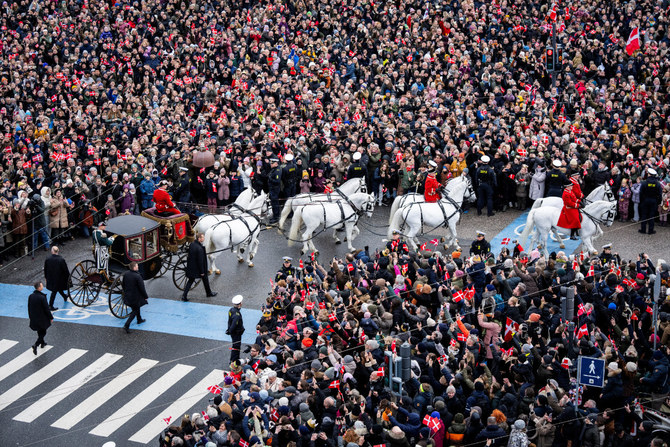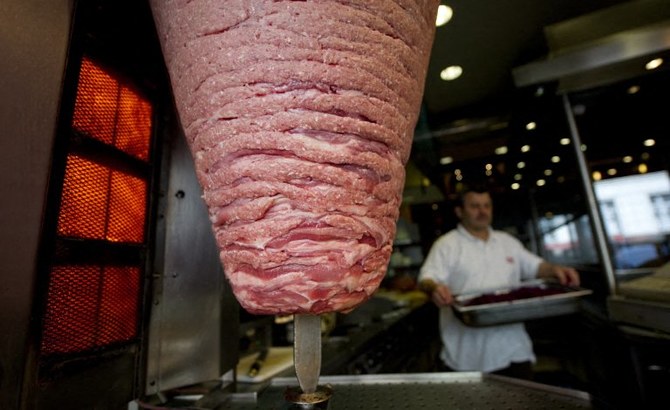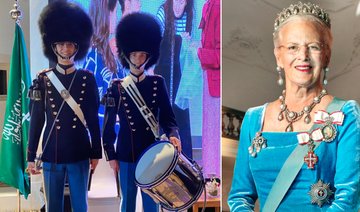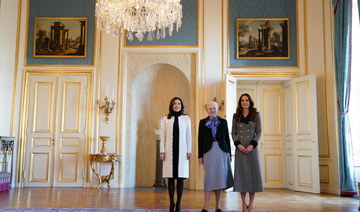COPENHAGEN: Denmark’s prime minister proclaimed Frederik X as king on Sunday after his mother Queen Margrethe II formally signed her abdication, with massive crowds turning out to rejoice in the throne passing from a beloved monarch to her popular son.
Margrethe, 83, is the first Danish monarch to voluntarily relinquish the throne in nearly 900 years. Many thousands of people gathered outside the palace where the royal succession took place, the mood jubilant as the Nordic nation experienced its first royal succession in more than a half-century, and one not caused by the death of a monarch.
Denmark’s monarchy traces its origins to 10th-century Viking king Gorm the Old, making it the oldest in Europe and one of the oldest in the world. Today the royal family’s duties are largely ceremonial.
Margrethe signed her abdication during a meeting with the government at the Christiansborg Palace, a vast complex in Copenhagen that has been the seat of Danish power for centuries. It now houses the Royal Reception Rooms and Royal Stables as well as the Danish Parliament, the prime minister’s office and the Supreme Court.
Prime Minister Mette Frederiksen next proclaimed Frederik king from the balcony of the palace before the cheering crowd.
Frederiksen read the proclamation three times, which is the tradition, as Frederik stood beside her wearing a ceremonial military uniform adorned with medals. He was then joined on the balcony by the new, Australian-born Queen Mary and the couple’s four children, and the crowd spontaneously sang the national anthem.
“My hope is to become a unifying king of tomorrow,” Frederik said. “It is a task I have approached all my life.”
It is the custom for each new sovereign to adopt a royal motto as a guiding principle for their reign, and Frederik’s is: “United, committed, for the kingdom of Denmark.”
“I want to return the trust I meet,” the new king said. “I need trust from my beloved wife, you and that which is greater than us.”
Frederik kissed Mary, the queen, who wore a white dress with a sash over one shoulder, and another great cheer rose from the crowd.
They then left Christianborg Palace in a horse-drawn coach as church bells rang out, and headed to their Amalienborg residence, where they once again appeared before people cheering and waving the nation’s flag of a white cross on a red background.
Frederik, who was visibly moved, placed both hands on his heart in a gesture of thanks.
The abdication document was earlier presented to Margrethe as she sat at a massive table covered in red cloth around which royals and members of the Danish government were seated. Frederik sat beside her.
After signing it, Margrethe, dressed in a magenta skirt suit, rose and gestured to Frederik to take her place. “God save the king,” she said as she left the room using a cane for support.
The abdication leaves Denmark with two queens: Margrethe keeps her title, while Frederik’s wife becomes Queen Mary. Frederik and Mary’s eldest son Christian, 18, has become crown prince and heir to the throne.
Citing health issues, Margrethe announced on New Year’s Eve that she would step down, stunning a nation that had expected her to live out her days on the throne, as is the tradition in the Danish monarchy. Margrethe underwent major back surgery last February and didn’t return to work until April.
Even the prime minister was unaware of the queen’s intentions until right before the announcement. Margrethe had informed Frederik and his younger brother Joachim just three days earlier, the Berlingske newspaper wrote, citing the royal palace.
People from across Denmark gathered outside parliament, with many swarming streets decorated with red-and-white Danish flags. Several shops hung photos of Margrethe and Frederik, while city buses were adorned with small Danish flags as is customary during royal events. Many others across the kingdom of nearly 6 million people followed a live television broadcast of the historic event.
“It was worth the four hours wait,” said Anders Pejtersen, 25. He made the trip from Aalborg, in northern Denmark, to witness Frederik’s proclamation. His mother, Helle Pejtersen, said “it was intense.”
Marina Gregovic, 32, a Copenhagen resident, said she believed Frederik “will be fantastic. And we loved his speech.”
Royals across Europe sent their congratulations including UK King Charles III, whose late mother Queen Elizabeth II and Margrethe were third cousins.
Charles said he was committed to working with them “on ensuring that the enduring bond between our countries, and our families, remains strong.”
Earlier in the day, the royal guards’ music band made their daily parade through downtown Copenhagen, but wore the red jackets used to mark major events, instead of their usual black.
The last time a Danish monarch voluntarily resigned was in 1146, when King Erik III Lam stepped down to enter a monastery. Margrethe abdicated on the same day of January that she ascended the throne following the death of her father, King Frederik IX, on Jan. 14, 1972.
Australians also turned out on the streets of Copenhagen to celebrate one of their own becoming queen.
“I think it’s good that she’s not from royalty and has a normal Australian background. We can relate more to that, because she’s from a middle-class background, and we are too,” said Judy Langtree, who made the long journey from Brisbane with her daughter to witness the royal event.
A survey — commissioned by Denmark’s public broadcaster DR — published Friday showed that 79 percent of the 1,037 people polled by the Epinion polling institute said that they believed Frederik was prepared to take the reigns and 83 percent said they thought his wife Mary was ready to become queen. The survey margin of error was 3 percentage points, DR said.
Though a hereditary monarchy might seem contradictory to the egalitarian principles of modern-day Denmark, the royal family remains highly popular and the anti-monarchist movement is small.
“The republicans in Denmark have no future,” former parliamentary Speaker Pia Kjærsgaard said on public television.
Frederik X is proclaimed king of Denmark after his mother Queen Margrethe II abdicates
https://arab.news/mcj4v
Frederik X is proclaimed king of Denmark after his mother Queen Margrethe II abdicates

- Margrethe, 83, is the first Danish monarch to voluntarily relinquish the throne in nearly 900 years
- Prime Minister Mette Frederiksen proclaimed Frederik king from the balcony of the royal palace before the cheering crowd
- Denmark’s monarchy traces its origins to 10th-century Viking king Gorm the Old
Miniature poodle Sage fetches top prize at Westminster Kennel Club Dog Show

- Sage, a 4-year-old black-colored female groomed in the fine, fluffy topiary style traditional for poodles, competed head to head against the winners in six other groups
- The Westminster dog show bills itself as the second-oldest US sporting event, behind only the Kentucky Derby thoroughbred horse race
NEW YORK: A sprightly miniature poodle named Sage was crowned “Best in Show” on Tuesday at the 148th annual Westminster Kennel Club Dog Show, winning the grand prize in the most prestigious competition among pure-bred canines in the United States.
Sage, the finalist representing 21 breeds classified as non-sporting dogs, triumphed over more than 2,500 top-ranked dogs competing in the two-day contest, held at the USTA Billie Jean King National Tennis Center in the Queens borough of New York City.
Sage, a 4-year-old black-colored female groomed in the fine, fluffy topiary style traditional for poodles, competed head to head against the winners in six other groups — terriers, hounds, herding dogs, working dogs, sporting dogs and toy dogs.
She was the first female to win the top prize at Westminster since 2020, according to commentators on the Fox Sports channel, which broadcast the event live.
And she became the fourth miniature poodle to claim the top prize in the 148-year history of the contest, with the trophy previously going to her breed in 1943, 1959 and 2002, according to kennel club records.
The larger “standard” poodle breed has been declared Best in Show five times, most recently in 2020, and the smaller “toy” poodle breed has won twice.
The poodle originated as a hunting dog in Germany and is now recognized as the national dog of France.
Sage’s handler, Kaz Hosaka, cried tears of joy and carried his prized poodle in his arms around floor of the auditorium to cheers of the crowd as he celebrated what he said was his 45th year participating at the Westminster dog show and the last of his career.
The Westminster dog show bills itself as the second-oldest US sporting event, behind only the Kentucky Derby thoroughbred horse race. This year’s competition drew a field of contenders representing 200 breeds from all 50 US states and 12 other countries.
Mercedes, a female 4-year-old German shepherd, was named runner-up for the overall contest, after first winning the top prize in the herding dog group.
Along with Sage and Mercedes, the two other finalists chosen on Monday were Comet the Shih Tzu, representing the toy group, and Louis, the Afghan hound leading the hound group.
Rounding out the finalists were three group winners chosen on Tuesday — Micah the black cocker spaniel, representing sporting dogs; Monty, the giant schnauzer, leading the working dogs; and Frankie, a colored bull terrier from the terrier group.
‘Miracle’ survivor found 5 days after building collapse

- When we went down to the side of the slab we had uncovered, we heard somebody inside, and we stopped all the heavy operations
JOHANNESBURG: Rescuers and onlookers cheered and applauded on Saturday as a survivor was rescued after 116 hours from underneath the rubble of a collapsed building in South Africa, with the tragedy having killed at least 13.
Provincial premier Alan Winde said on X: “It is a miracle that we have all been hoping for.”
An apartment block under construction in the southern city of George crumbled on Monday afternoon while an 81-person crew was on site.
“When we went down to the side of the slab we had uncovered, we heard somebody inside, and we stopped all the heavy operations,” Colin Deiner, head of rescue operations, told reporters.
Rescuers then called out to the survivor, and he spoke back, Deiner said.
“He indicated to us that he’s got weight on his legs, and we’re very concerned about that after such a long period.” After several hours, the survivor was extricated and rushed to a hospital.
Rescue teams have been working against time since the structure came crashing down.
Twenty-nine people were rescued alive, while thirty-nine remained unaccounted for.
Winde said a “difficult” identification process was underway, and police were using fingerprints, DNA testing, and photographs.
The city had approved construction plans for a 42-unit apartment block in July.
The reasons for the collapse are still unknown.
Biden jokes Trump should have injected himself with bleach

- Biden also made light of Trump’s “love letters” from North Korean leader Kim Jong Un
- In a senior moment, Biden mistakenly referred to Kim as the president of South Korea
PORTOLA VALLEY, California: US President Joe Biden joked on Friday that he wished former President Donald Trump had injected himself with a little bleach, resurrecting one of Trump’s more head-scratching moments from the early days of the coronavirus pandemic.
Biden, at a fundraising event south of San Francisco for his re-election campaign, said the presidency of his Republican opponent was chaotic and that voters should keep that in mind. Biden and Trump are locked in a close contest ahead of the November election.
“Remember him saying the best thing to do is just inject a little bleach in your arm? That’s what he said. And he meant it. I wish he had done a little bit himself,” Biden said.
During the early months of the pandemic in 2020, Trump said that an “injection inside” the human body with a disinfectant like bleach or isopropyl alcohol could help protect against the virus.
Biden also made light of what he called Trump’s “love letters” from North Korean leader Kim Jong Un, although Biden mistakenly referred to Kim as the president of South Korea.
Trump had met with Kim and exchanged a number of letters with him, copies of which he kept in a loose-leaf binder in the Oval Office.
A spokesperson for the Trump campaign did not immediately respond to a request for comment on Biden’s remarks.
Biden has made light of Trump’s bleach comment before, saying on April 24 in Washington that Trump had injected himself and “it all went to his hair.”
Meaty issue: German political party calls for €4.90 price cap on doner kebabs

- Die Linke appeals to government as price of national favorite hits €10 in some cities
- Scheme would cost taxpayer about €4bn
LONDON: German political party Die Linke has urged the government to cap the price of a much loved food item — the doner kebab.
The party has proposed providing daily vouchers to households that would limit prices to €4.90 ($5.28) and €2.90 for young people under an initiative known as Donerpreisbremse.
The scheme is projected to cost the government about €4 billion.
Introduced after the Second World War by Turkish immigrants who adapted the dish to suit local tastes, the doner kebab is a national favorite in Germany, with an estimated 1.3 billion consumed annually. But their soaring price has become a hot-button political issue.
Die Linke said the cost of a doner kebab had reached €10 in some cities, from €4 just two years ago.
“For young people right now it is an issue as important as where they will move when they leave home,” said Hanna Steinmuller, a lawmaker with the Greens party.
“I know it’s not an everyday issue for many people here … but I think as voter representatives we are obliged to highlight these different perspectives.”
German Chancellor Olaf Scholz was famously confronted by a voter last year who demanded he “speak with Putin … I’m paying €8 for a doner.”
With public pressure mounting, Scholz recently acknowledged on social media that “everywhere I go, mostly by young people, I get asked if there should be a price cap for doner kebabs.”
Despite the appeals, the chancellor rejected the proposal, citing the impracticality of price controls in a free market economy.
Despite its humble origins as a street food, the doner kebab has become an unexpected point of political focus.
Last month, German President Frank-Walter Steinmeier sparked controversy when on a visit to Turkiye he gifted 60 kg of kebab meat from Berlin to Istanbul in what some called a clumsy attempt to symbolize the strong cultural ties between the two nations.
A 98-year-old in Ukraine walked miles to safety from Russians, with slippers and a cane

- Describing her journey, the nonagenarian said she had fallen twice and was forced to stop to rest at some points, even sleeping along the way before waking up and continuing her journey
KYIV, Ukraine: A 98-year-old woman in Ukraine who escaped Russian-occupied territory by walking almost 10 kilometers (6 miles) alone, wearing a pair of slippers and supported by a cane has been reunited with her family days after they were separated while fleeing to safety.
Lidia Stepanivna Lomikovska and her family decided to leave the frontline town of Ocheretyne, in the eastern Donetsk region, last week after Russian troops entered it and fighting intensified.
Russians have been advancing in the area, pounding Kyiv’s depleted, ammunition-deprived forces with artillery, drones and bombs.
“I woke up surrounded by shooting all around — so scary,” Lomikovska said in a video interview posted by the National Police of Donetsk region.
In the chaos of the departure, Lomikovska became separated from her son and two daughters-in-law, including one, Olha Lomikovska, injured by shrapnel days earlier. The younger family members took to back routes, but Lydia wanted to stay on the main road.
With a cane in one hand and steadying herself using a splintered piece of wood in the other, the pensioner walked all day without food and water to reach Ukrainian lines.
Describing her journey, the nonagenarian said she had fallen twice and was forced to stop to rest at some points, even sleeping along the way before waking up and continuing her journey.
“Once I lost balance and fell into weeds. I fell asleep … a little, and continued walking. And then, for the second time, again, I fell. But then I got up and thought to myself: “I need to keep walking, bit by bit,’” Lomikovska said.
Pavlo Diachenko, acting spokesman for the National Police of Ukraine in the Donetsk region, said Lomikovska was saved when Ukrainian soldiers spotted her walking along the road in the evening. They handed her over to the “White Angels,” a police group that evacuates citizens living on the front line, who then took her to a shelter for evacuees and contacted her relatives.
“I survived that war,’ she said referring to World War II. “I had to go through this war too, and in the end, I am left with nothing.
“That war wasn’t like this one. I saw that war. Not a single house burned down. But now – everything is on fire,” she said to her rescuer.
In the latest twist to the story, the chief executive of one of Ukraine’s largest banks announced on his Telegram channel Tuesday that the bank would purchase a house for the pensioner.
“Monobank will buy Lydia Stepanivna a house and she will surely live in it until the moment when this abomination disappears from our land,” Oleh Horokhovskyi said.

























